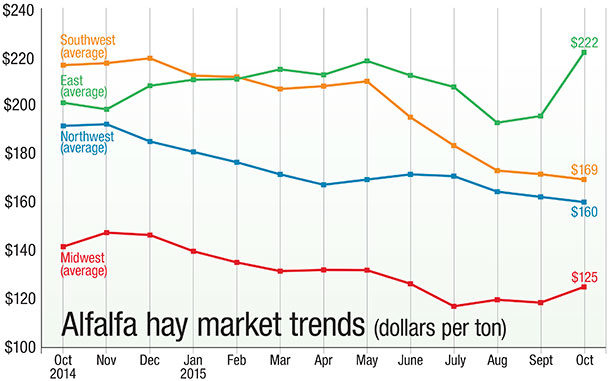Average pricing across eastern states was reported at $222 per ton for alfalfa hay (up from $196) and $167 per ton for other hay (up from $143). Other areas of the country reported swings of only $6 per ton gain or loss on all hay.
Other hay prices
Individual state winners in October with gains in the “other hay” market include New York (up $56 per ton), Pennsylvania (up $18 per ton), Ohio (up $15 per ton) and Nebraska (up $11 per ton). Honorable mentions go to Illinois, New Mexico and Wyoming (all up $10 per ton).
Losers in the hay market in October included Oregon (down $20 per ton) and Colorado (down $15 per ton).
Alfalfa hay prices
Individual state winners in October with gains in the alfalfa market include New York (up $58 per ton), Minnesota (up $39 per ton), Pennsylvania (up $32 per ton), Michigan and Ohio (up $15 per ton).
Those states that received the largest drop in pricing in October for alfalfa hay included Texas ($14 per ton lower) and Colorado ($10 per ton lower).
Weather
Weather.com lists the Nevada Sierra snowpack at more than 200 percent above average (snow-water content), with 30 inches of snow at the peak, as of Nov. 19. Although it is still very early in the season, this indication is promising that perhaps the long-touted “strongest El Nino” in years will actually come to fruition. California, in the fourth year of their historic drought, relies on the snowpack from the Sierra Nevada Mountains for irrigation water and reservoir refill. A drought that lasts that long, however, takes a significant amount of time to recover, and winter has only begun. Meteorologists say the drought conditions, even through a wet El Nino, will take some time to recover.
Exports
The USDA Foreign Agricultural Service reported hay exports year-to-date at $1,121.3 million. This is 1 percent over 2014 values. Leading hay export markets for October through September are Japan, China, Korea, UAE and Taiwan. China increased 21.9 percent over this time last year, perhaps not surprising due to the GMO issue and longshoremen strike that hampered exports in 2014. During that same time period, UAE actually dropped 31.9 percent in hay exported to that country, although it still remains fourth on the top-five list of hay export countries. The top four markets remain unchanged from 2014, with 92.4 percent of export hay shipped to these countries (in order of hay value, as listed above).
While year-to-date value figures showed positive gain, export quantities for September fell by 10 percent. Quantities to China and Korea fell sharply, creating the overall impact. China fell from 89,871 metric tons in August to 67,403 metric tons in September. Korea fell from 51,853 metric tons in August to 44,113 metric tons in September.
Dairy market
The dairy outlook by Bob Cropp, professor emeritus for the University of Wisconsin – Madison, reports little change in milk prices from October. The week of Nov. 19, Cropp said, “But it looks like milk prices could weaken considerably as we end the year and for the first quarter of next year. Milk production is increasing seasonally, and the holiday orders of butter and cheese for Thanksgiving and Christmas are about filled.” Cropp said milk prices ahead are heading lower, with butter prices likely to soon decline. A short-term rally is unlikely.

Trend charts
Hay markets vary widely by region and by product – alfalfa hay versus “other hay.” The prices and information in Figure 1 (alfalfa hay market trends) and Figure 2 (“other hay” market trends) are provided by NASS and reflect general price trends and movements. Hay quality, however, was not provided in the NASS reports.
For purposes of this report, states that provided data to NASS were divided into the following regions:
Southwest – Arizona, California, Nevada, New Mexico, Oklahoma, Texas
East – Kentucky, New York, Ohio, Pennsylvania
Northwest – Colorado, Idaho, Montana, Oregon, Utah, Washington, Wyoming
Midwest – Illinois, Iowa, Kansas, Michigan, Minnesota, Missouri, Nebraska, North Dakota, South Dakota, Wisconsin FG











